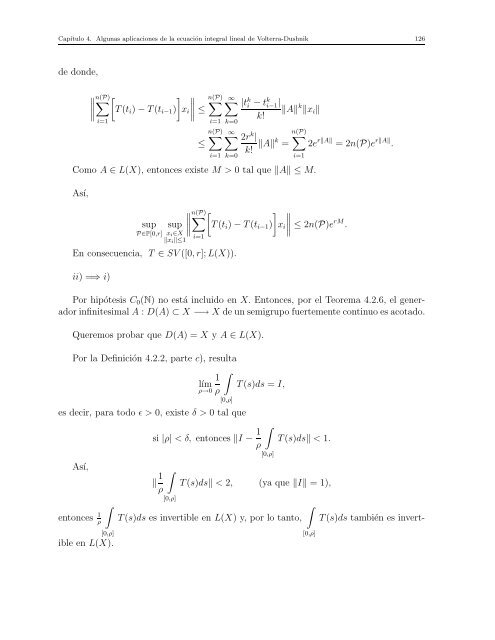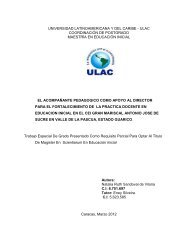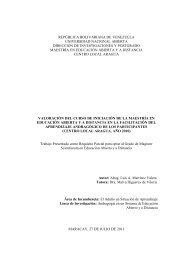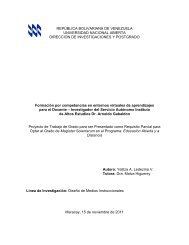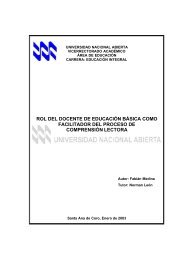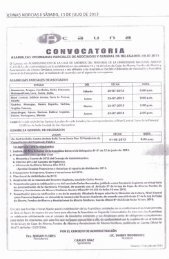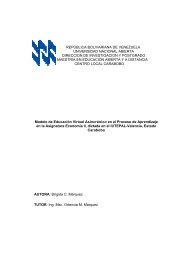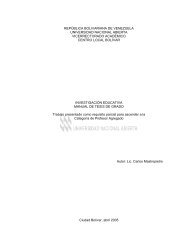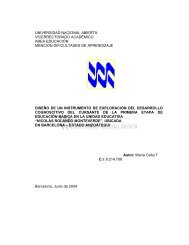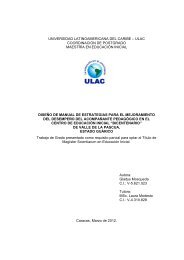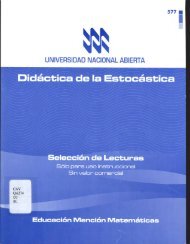- Page 1 and 2:
REPUBLICA BOLIVARIANA DE VENEZUELAU
- Page 3 and 4:
Índice generalIntroducciónIII1. N
- Page 5 and 6:
IntroducciónivIntroducciónConside
- Page 7 and 8:
IntroducciónviEstudiar la ecuació
- Page 9 and 10:
Introducciónviiix u(t) = u(t) −
- Page 11 and 12:
Capítulo 1. Notaciones y resultado
- Page 13 and 14:
Capítulo 1. Notaciones y resultado
- Page 15 and 16:
Capítulo 1. Notaciones y resultado
- Page 17 and 18:
Capítulo 1. Notaciones y resultado
- Page 19 and 20:
Capítulo 1. Notaciones y resultado
- Page 21 and 22:
Capítulo 1. Notaciones y resultado
- Page 23 and 24:
Capítulo 1. Notaciones y resultado
- Page 25 and 26:
Capítulo 1. Notaciones y resultado
- Page 27 and 28:
Capítulo 1. Notaciones y resultado
- Page 29 and 30:
Capítulo 1. Notaciones y resultado
- Page 31 and 32:
Capítulo 1. Notaciones y resultado
- Page 33 and 34:
Capítulo 1. Notaciones y resultado
- Page 36 and 37:
Capítulo 1. Notaciones y resultado
- Page 38 and 39:
Capítulo 1. Notaciones y resultado
- Page 40 and 41:
Capítulo 1. Notaciones y resultado
- Page 42 and 43:
Capítulo 1. Notaciones y resultado
- Page 44 and 45:
Capítulo 2Integral de DushnikNos p
- Page 46 and 47:
Capítulo 2. Integral de Dushnik 37
- Page 48 and 49:
Capítulo 2. Integral de Dushnik 39
- Page 50 and 51:
Capítulo 2. Integral de Dushnik 41
- Page 52 and 53:
Capítulo 2. Integral de Dushnik 43
- Page 54 and 55:
Capítulo 2. Integral de Dushnik 45
- Page 56 and 57:
Capítulo 2. Integral de Dushnik 47
- Page 58 and 59:
Capítulo 2. Integral de Dushnik 49
- Page 60 and 61:
Capítulo 2. Integral de Dushnik 51
- Page 62 and 63:
Capítulo 2. Integral de Dushnik 53
- Page 64 and 65:
Capítulo 3Existencia y unicidad de
- Page 66 and 67:
Capítulo 3. Existencia y unicidad
- Page 68 and 69:
Capítulo 3. Existencia y unicidad
- Page 70 and 71:
Capítulo 3. Existencia y unicidad
- Page 72 and 73:
Capítulo 3. Existencia y unicidad
- Page 74 and 75:
Capítulo 3. Existencia y unicidad
- Page 76 and 77:
Capítulo 3. Existencia y unicidad
- Page 78 and 79:
Capítulo 3. Existencia y unicidad
- Page 80 and 81:
Capítulo 3. Existencia y unicidad
- Page 82 and 83:
Capítulo 3. Existencia y unicidad
- Page 84 and 85: Capítulo 3. Existencia y unicidad
- Page 86 and 87: Capítulo 3. Existencia y unicidad
- Page 88 and 89: Capítulo 3. Existencia y unicidad
- Page 90 and 91: Capítulo 3. Existencia y unicidad
- Page 92 and 93: Capítulo 4. Algunas aplicaciones d
- Page 94 and 95: Capítulo 4. Algunas aplicaciones d
- Page 96 and 97: Capítulo 4. Algunas aplicaciones d
- Page 98 and 99: Capítulo 4. Algunas aplicaciones d
- Page 100 and 101: Capítulo 4. Algunas aplicaciones d
- Page 102 and 103: Capítulo 4. Algunas aplicaciones d
- Page 104 and 105: Capítulo 4. Algunas aplicaciones d
- Page 106 and 107: Capítulo 4. Algunas aplicaciones d
- Page 108 and 109: Capítulo 4. Algunas aplicaciones d
- Page 110 and 111: Capítulo 4. Algunas aplicaciones d
- Page 112 and 113: Capítulo 4. Algunas aplicaciones d
- Page 114 and 115: Capítulo 4. Algunas aplicaciones d
- Page 116 and 117: Capítulo 4. Algunas aplicaciones d
- Page 118 and 119: Capítulo 4. Algunas aplicaciones d
- Page 120 and 121: Capítulo 4. Algunas aplicaciones d
- Page 122 and 123: Capítulo 4. Algunas aplicaciones d
- Page 124 and 125: Capítulo 4. Algunas aplicaciones d
- Page 126 and 127: Capítulo 4. Algunas aplicaciones d
- Page 128 and 129: Capítulo 4. Algunas aplicaciones d
- Page 130 and 131: Capítulo 4. Algunas aplicaciones d
- Page 132 and 133: Capítulo 4. Algunas aplicaciones d
- Page 136 and 137: Capítulo 4. Algunas aplicaciones d
- Page 138 and 139: Apéndice AA.1. NotacionesN : Núme
- Page 140 and 141: Anexo A. Algunas aplicaciones de la
- Page 142: Bibliografía 133[10] C.S. Hönig.


